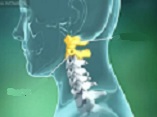Novelty in Management of Traumatic Posterior Atlantoaxial Subluxation without Associated Fractures; A Case Report
Innovative Treatment for Atlantoaxial Subluxation
DOI:
https://doi.org/10.31661/gmj.vi.3704Keywords:
Posterior Atlantoaxial Subluxation; Fracture; ImpactorAbstract
Background: Trauma is the main reason for Atlantoaxial subluxation in adults. The subluxation without fractures is extremely rare. Also, posterior atlantoaxial dislocation without odontoid fracture is extraordinarily uncommon and regularly causes deadly spinal cord injury. Based on the literature, there are few reports of approximately stressful posterior atlantoaxial dislocation, with incomplete quadriplegia related to a spinal cord injury. Case Presentation: This report describes a 23-year-old Iranian man who was involved in a motor-to-barrier accident. He was hemodynamically stable with a Glasgow Coma Scale of 15/15 but exhibited cervical tenderness (C1-C2). A CT scan revealed a posterior C1-C2 subluxation, with the odontoid process anterior to the atlas and no fractures. Under general anesthesia, a fluoroscopy guide, and C-ARM imaging monitoring, flexion of the head and neck with traction was done. During the procedure, the odontoid process was locked in the inferior of the anterior C1 arch, Therefore, we decided to push back the odontoid process by using an Impactor through the retro pharynx. The maneuver was successful, and the odontoid was placed in its position. Conclusion: The stability of the atlantoaxial complex relies on its anatomy, which can be affected by trauma or congenital issues. Closed reduction followed by C1-C2 arthrodesis is the preferred treatment. Innovative methods, like using an impactor for closed reduction, need further study to improve outcomes. Surgeons must evaluate each case based on the patient’s specific situation.
References
Bellil M, Hadhri K, Sridi M, Kooli M. Traumatic atlantoaxial rotatory fixation associated with C2 articular facet fracture in adult patient: Case report. J Craniovertebr Junction Spine. 2014 Oct;5(4):163-6.
https://doi.org/10.4103/0974-8237.147083
PMid:25558147 PMCid:PMC4279279
Schleicher P, Pingel A, Kandziora F. Safe management of acute cervical spine injuries. EFORT Open Rev. 2018 May 21;3(5):347-357.
https://doi.org/10.1302/2058-5241.3.170076
PMid:29951274 PMCid:PMC5994619
Moyo L, Musara A, Kalangu K. Traumatic posterior atlantoaxial dislocation without related fractures of c1-c2 in a patient with traumatic brain injury: case report and literature review. Int J Neurosurg. 2019;3(3):5-8.
https://doi.org/10.11648/j.ijn.20190301.12
HARALSON III RH, Boyd HB. Posterior dislocation of the atlas on the axis without fracture: Report of a case. JBJS. 1969 Apr 1;51(3):561-6.
https://doi.org/10.2106/00004623-196951030-00016
Sassard WR, HEINIG CF, Pitts WR. Posterior atlanto-axial dislocation without fracture: case report with successful conservative treatment. JBJS. 1974 Apr 1;56(3):625-8.
https://doi.org/10.2106/00004623-197456030-00023
Patzakis MJ, Knopf A, Elfering M, Hoffer M, Harvey JPJ. Posterior dislocation of the atlas on the axis; a case report. J Bone Joint Surg Am. 1974 Sep;56(6):1260-2.
https://doi.org/10.2106/00004623-197456060-00020
Fox JL, Jerez A. An unusual atlanto-axial dislocation: case report. Journal of Neurosurgery. 1977 Jul 1;47(1):115-8.
https://doi.org/10.3171/jns.1977.47.1.0115
PMid:864499
Jamshidi S, Dennis MW, Azzam C, Karim N. Traumatic posterior atlantoaxial dislocation without neurological deficit: case report. Neurosurgery. 1983 Feb;12(2):211-3.
https://doi.org/10.1227/00006123-198302000-00014
PMid:6835503
Wong DA, Mack RP, Craigmile TK. Traumatic atlantoaxial dislocation without fracture of the odontoid. Spine (Phila Pa 1976). 1991 May;16(5):587-9.
https://doi.org/10.1097/00007632-199105000-00021
PMid:2053005
Sud S, Chaturvedi S, Buxi TBS, Singh S. Posterior atlantoaxial dislocation without associated fracture. Skeletal Radiol. 2002 Sep;31(9):529-31.
https://doi.org/10.1007/s00256-002-0540-x
PMid:12195506
Yang KH, Kim KN, Oh SH. Posterior atlantoaxial dislocation without fracture: Case report. Journal of Neurosurgery: Spine. 2003 Jan 1;98(1):73-6.
https://doi.org/10.3171/spi.2003.98.1.0073
PMid:12546392
Neumann U, Urbanski H, Riedel K. Posterior atlantoaxial dislocation without fracture of the odontoid: a case report. JBJS. 2003 Jul 1;85(7):1343-6.
https://doi.org/10.2106/00004623-200307000-00023
PMid:12851361
Chaudhary R, Chaudhary K, Metkar U, Rathod A, Raut A, Sanghvi D. Posterior atlantoaxial dislocation without odontoid fracture. Skeletal Radiol. 2008 Apr;37(4):361-6.
https://doi.org/10.1007/s00256-007-0439-7
PMid:18259747
Xu Y, Li F, Guan H, Xiong W. Traumatic Posterior Atlantoaxial Dislocation Without Associated Fracture but With Neurological Deficit: A Case Report and Literature Review. Medicine (Baltimore). 2015 Oct;94(43):e1768.
https://doi.org/10.1097/MD.0000000000001768
PMid:26512572 PMCid:PMC4985386
Ghailane S, Alsofyani MA, Pointillart V, Bouloussa H, Gille O. Traumatic posterior Atlanto-axial dislocation: case report of an atypical C1-C2 dislocation with an anterior arch fracture of C1. BMC Musculoskelet Disord. 2019 Dec 20;20(1):612.
https://doi.org/10.1186/s12891-019-3005-2
PMid:31861991 PMCid:PMC6925510
Spitnale MJ, Grabowski G. Classification in Brief: Subaxial Cervical Spine Injury Classification and Severity Score System. Clin Orthop Relat Res. 2020 Oct;478(10):2390-2398.
https://doi.org/10.1097/CORR.0000000000001463
PMid:32925240 PMCid:PMC7491911
Jiang LS, Shen L, Wang W, Wu H, Dai LY. Posterior atlantoaxial dislocation without fracture and neurologic deficit: a case report and the review of literature. Eur Spine J. 2010 Jul;19 Suppl 2(Suppl 2):S118-23.
https://doi.org/10.1007/s00586-009-1150-2
PMid:19714372 PMCid:PMC2899621
Yang SY, Boniello AJ, Poorman CE, Chang AL, Wang S, Passias PG. A review of the diagnosis and treatment of atlantoaxial dislocations. Glob spine J. 2014 Aug;4(3):197-210.
https://doi.org/10.1055/s-0034-1376371
PMid:25083363 PMCid:PMC4111952

Published
How to Cite
Issue
Section
License
Copyright (c) 2025 Galen Medical Journal

This work is licensed under a Creative Commons Attribution 4.0 International License.







